Kyoto (Eastern)
Sanjusangendo
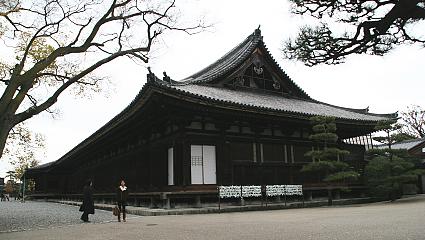
Sanjusangendo is the popular name for Rengeo-in, a temple in eastern Kyoto which is famous for its 1001 statues of Kannon, the goddess of mercy. The temple was founded in 1164 and its present structures date from 1266.
The main hall, which houses the statues, is with over 100 meters Japan's longest wooden structure. In its center sits one large Kannon, flanked on each side by 500 smaller statues, standing in neat rows side by side, each as tall as a human being.
Sanjusangendo is a 15-20 minute walk or a short bus ride (lines 100, 206 or 208) from Kyoto Station.
Kiyomizudera
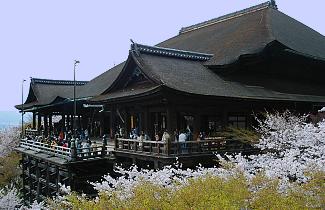
Kiyomizudera ("Pure Water Temple") is one of the most celebrated temples of Japan. It was founded in 780 and remains associated with the Hosso sect, one of the oldest sects within Japanese Buddhism. In 1994, the temple was added to the list of UNESCO world heritage sites.
Kiyomizudera stands in the wooded hills of eastern Kyoto and offers visitors a nice view over the city from its famous wooden terrace. Below the terrace, you can taste the spring water, which gives the temple its name and which is said to have healing power.
Behind Kyomizudera's main hall stands Jishu Shrine, a shrine dedicated to the deity of love. In front of the shrine are two rocks, placed several meters apart from each other. Successfully walking from one to the other rock with your eyes closed is said to bring luck in your love live.
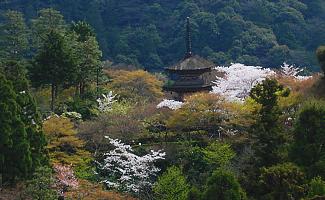
Part of the fun of visiting Kiyomizudera is the approach to the temple along the steep and busy lanes of the atmospheric Higashiyama district. Except early in the morning, do not expect a tranquil, spiritual atmosphere.
The many shops, restaurants and ryokan in the area have been catering to tourists and pilgrims for centuries. Products on sale range from local specialties such as Kiyomizu-yaki pottery, sweets and pickles to the standard set of souvenirs.
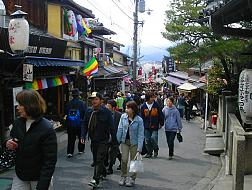 | 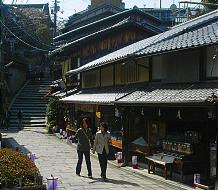 |
Kiyomizudera can be reached from Kyoto Station in about 15 minutes by bus. Take bus number 100 or 206 and get off at Kiyomizu-michi or Gojo-zaka, from where it is a 10-15 minute uphill walk to the temple.
Kodaiji
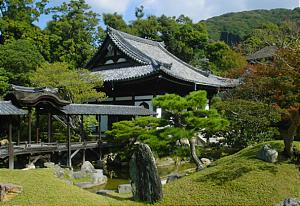
Kodaiji is one of the many outstanding temples in Kyoto's Higashiyama district.
It was constructed in 1605 in memory of Toyotomi Hideyoshi by the great political leader's wife. Besides fine temple halls, Kodaiji features a small bamboo grove and a landscape garden with tea houses, designed by leading, contemporary masters.
Beautiful, Zen style illumination shows are held in Kodaiji's garden during certain times of the year.
Kodaiji is located in the Higashiyama district between Yasaka Shrine and Kiyomizudera.
Gion
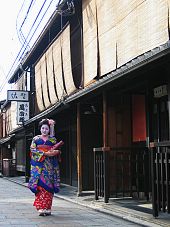 | 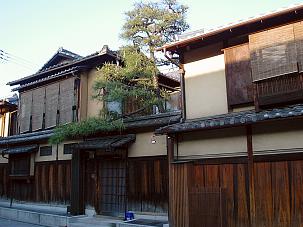 |
Gion is Kyoto's most famous geisha district. To experience the traditional Gion, stroll along Hanami-koji, a street lined by beautiful old buildings, teahouses and restaurants. In the evenings, you may be able to spot a geisha apprentice.
Yasaka Shrine and the Minamiza kabuki theater are some of Gion's other attractions.
Gion can be reached by bus from Kyoto Station in about 20 minutes. Take number 100 and 206 and get off at Gion bus stop. The closest train stations are Shijo Station on the Keihan Line and Kawaramachi Station on the Hankyu Line.
Yasaka Shrine

Yasaka Shrine, also known as Gion Shrine, is famous for its Gion Matsuri, one of Japan's largest festivals. It is located at the eastern end of Shijo-dori and is one of the city's most popular shrines. The many lanterns that decorate the shrine's stage are lit after dark and bear the names of their sponsors, mostly Kyoto businesses.
Located just next to shrine grounds is Maruyama Park, Kyoto's most popular spot for enjoying cherry blossoms in spring.
Chionin

Chionin is the head temple of the Jodo (Pure Land) sect of Japanese Buddhism. The Jodo sect was founded by Honen in the year 1175, and due to its relatively simple teachings, attracted large numbers of followers among the commoners and remains one of the largest Buddhist sects today.
Chionin was built in 1234, but the currently oldest buildings date from the 17th century. Among them is the Sanmon gate, Japan's largest temple gate, standing 24 meters tall. Another record breaking property on the temple grounds, Japan's largest bell weights more than several city buses combined.
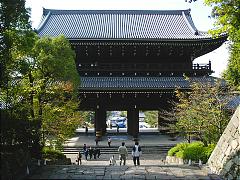 | 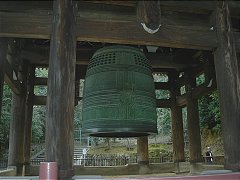 |
Chionin is located immediately north of Maruyama Park and Yasaka Shrine. The closest subway station is Higashiyama Station on the Tozai Line.
Heian Shrine
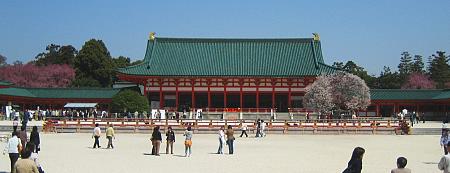
Heian Shrine was built relatively recently in 1895 on the occasion of the 1,100th anniversary of the Heian Capital foundation. It is dedicated to the first and last emperors that reigned from Kyoto, Emperor Kammu and Emperor Komei.
The shrine buildings are a partial replica of the Imperial Palace of the Heian Period, but only about two thirds of the original buildings in scale. Several events are held on the shrine's spacious inner court occasionally.
A nice garden is located behind the shrine's main buildings. A visit is most beautiful in April, when the garden's many weeping cherry trees are in full bloom. An admission fee applies only to visiting the garden (see details below).
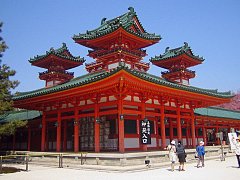 | 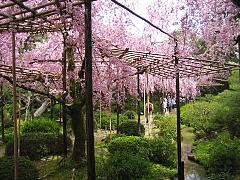 |
Heian Shrine can be reached by bus number 5 or 100 from Kyoto Station. A more reliable (and probably faster) alternative is by subway to Higashiyama Station on the Tozai Line (requires a transfer at Karasuma Oike Station from the Karasuma Line) followed by a 10 minute walk to the shrine.
Nanzenji
Nanzenji is a Zen temple at the foot of Kyoto's eastern hills. As head temple of the Rinzai sect's Nanzenji school of Zen Buddhism, it is one of Japan's most important Zen temples.
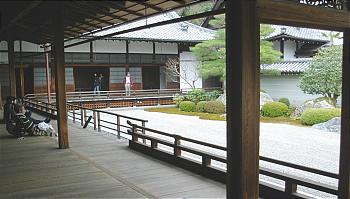
Nanzenji was first built as an imperial villa in 1264, and became a temple in 1291. Its main building, the Seiryo-den, is famous for a beautiful rock garden and sliding doors (fusuma), which are decorated by paintings of the Kano School.
The temple's large entrance gate, completed in 1628, is called Sanmon. Several subtemples and a water aqueduct, which is part of the Lake Biwa Canal dating from 1890, can be found in the vicinity of Nanzenji's main buildings.
Among the subtemples open to the public are Nanzenin, directly behind the water aqueduct, whose small but pretty garden is particularly spectacular with autumn leaves (usually best in the second half of November), and the scarcely visited Konchiin, standing southwest of the Sanmon gate.
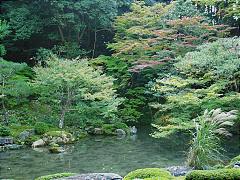 | 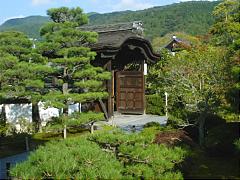 |
Nanzenji can be reached by bus number 5 from Kyoto Station. Alternatively, take the subway Tozai Line to Keage Station (transfer from Karasuma Line at Karasuma Oike Station) from where the temple can be reached in a 10 minute walk.
Nanzenji is also a good starting or end point for a walk along the Path of Philosophy to/from Ginkakuji.
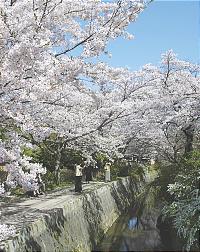
Walk of Philosophy
The Walk of Philosophy (Tetsugaku no michi) is a pleasant path besides a canal that connects Ginkakuji (Silver Pavilion) with the vicinity of Nanzenji.
Cherry trees are planted along most of the over one kilometer long path, making it one of Kyoto's most popular spots for hanami (cherry blossom viewing) in spring. The trees are usually in bloom in the beginning to mid April.
In addition, several smaller temples and a few restaurants can be found along the way.
Start the walk at either Ginkakuji or Nanzenji. Note that the path starts/ends a 5-10 minute walk north of Nanzenji.
Ginkakuji

Ginkakuji, the Silver Pavilion, is a Zen temple at the foot of Kyoto's Higashiyama ("eastern mountains"). The temple is formally known as Tozan Jishoji.
In 1482, shogun Ashikaga Yoshimasa built his retirement villa on the grounds of today's temple. A few years later, the Silver Pavilion, modeled after Kinkakuji (Golden Pavilion), was constructed. Plans to cover the pavilion in silver were never realized.
The villa was converted into a Zen temple after Yoshimasa's death in 1490.
Ginkakuji can be accessed by direct bus number 5, 17 or 100 from Kyoto Station. Alternatively, you can reach Ginkakuji by foot along the Path of Philosophy from Nanzenji.